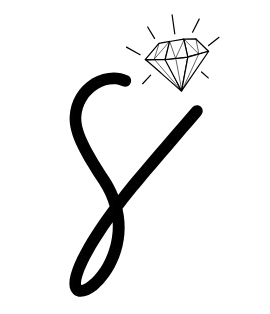Last winter, while helping a friend inspect an heirloom diamond ring under UV light, we both stared in disbelief as the stone suddenly lit up in a bluish glow. Was it fake? Radioactive? Or was this some kind of hidden feature no one told us about? That moment kicked off a rabbit hole of research and hands-on testing that led to a surprising realisation: diamonds do glow under black light — and it can tell you a lot more than you’d expect.
But before you start shining a UV torch on every stone in your jewellery box, let’s unravel what that glow really means.
What Does It Mean When a Diamond Glows Under Black Light?
The Science Behind the Glow
Diamonds are made of carbon, but their atomic structure isn’t always flawless. When exposed to ultraviolet (UV) light (commonly referred to as “black light”), around 25% to 35% of natural diamonds fluoresce, often glowing a bluish colour. This phenomenon is due to trace elements like nitrogen within the diamond’s structure that react under UV light.
According to the Gemological Institute of America (GIA), the majority of diamonds that fluoresce emit a blue glow, though yellow, green, orange, and even white fluorescences have been observed. The glow lasts only while the diamond is exposed to UV light and disappears immediately afterward.
“Fluorescence is a natural property in diamonds and is generally not harmful or indicative of quality,” explains Dr. James Earl, gemmologist at the London School of Jewellery Sciences.
Is Fluorescence in Diamonds Good or Bad?
It Depends on the Diamond
Fluorescence has long been misunderstood. While some buyers fear it might indicate poor quality, that’s not entirely true. For diamonds with slight yellow tints (typically grades I to M), blue fluorescence can actually make the stone appear whiter and more brilliant under normal lighting.
However, in high-colour diamonds (D to F grades), strong fluorescence might cause a hazy or oily appearance in rare cases. That said, most fluorescence is so faint it has no visible impact at all.
In fact, during a visit to Hatton Garden in London, a seasoned jeweller showed me two diamonds of identical cut and clarity. One fluoresced strongly; the other didn’t. Visually, I couldn’t tell them apart. Yet, the fluorescent one was priced slightly lower.
A Financial Perspective
Because of outdated misconceptions, fluorescent diamonds often sell for 10-15% less, making them a good deal for savvy buyers who aren’t influenced by myths.
Why Do Only Some Diamonds Fluoresce?
Fluorescence primarily occurs in natural diamonds due to structural irregularities or the presence of certain trace minerals. Lab-grown diamonds can fluoresce too, but their glow often differs in pattern and intensity.
Here’s a quick breakdown:
- Natural diamonds: Roughly 1 in 3 show fluorescence (most commonly blue).
- Lab-grown diamonds: Fluorescence varies by growth method (HPHT vs. CVD).
- Simulants (like cubic zirconia): May glow, but with distinctly different characteristics.
A 2020 study by the GIA found that HPHT (high pressure, high temperature) lab-grown diamonds tend to fluoresce under shortwave UV light, whereas natural diamonds mostly respond to longwave UV.
How Can You Tell If Your Diamond Will Glow?
Home Testing
All you need is a dark room and a UV flashlight (easily available online). Hold the diamond under the black light and observe any glow. Bluish light? Likely fluorescence. No glow? It just doesn’t fluoresce.
I tested five diamonds in my family’s collection. Three glowed blue, one stayed dull, and another surprised me with a pale yellow hue. Turns out, that one was a moissanite.
Professional Grading
The best way to confirm is to check the diamond’s grading report. GIA and IGI certificates typically mention the fluorescence level:
- None
- Faint
- Medium
- Strong
- Very Strong
This scale is helpful when choosing a diamond, especially if you’re particular about visual performance.
Common Myths About Diamond Fluorescence
- “Fluorescence means the diamond is fake” ✖️ False. In fact, fluorescence is more common in natural diamonds than synthetics.
- “Fluorescence makes diamonds glow in the dark” ✖️ Not exactly. They glow under UV light but won’t radiate in the dark on their own.
- “All fluorescent diamonds look hazy” ✖️ Not true. Most fluorescence has no visible effect without UV light.
Real-Life Example: Wedding Ring Confusion
One of my readers recently emailed me about her engagement ring, which appeared to glow blue in a nightclub. She panicked, assuming it was fake. Turns out, it was a naturally fluorescent diamond with a medium rating. Not only was it real, but that glow actually added a little magic to the story behind her ring.
Frequently Asked Questions (FAQs)
Q: Does diamond fluorescence affect resale value?
A: It can, but usually not significantly. Diamonds with strong fluorescence may be priced lower, offering better value for buyers.
Q: Is fluorescence visible in daylight?
A: Not usually. It mainly shows under UV or black light.
Q: Can fluorescence help identify synthetic diamonds?
A: Sometimes. Lab-grown diamonds can fluoresce differently, but this is not a foolproof method.
Q: Is fluorescence harmful?
A: Not at all. It’s a natural optical property and poses no health risk.
Related: What Diamond Cut Sparkles the Most?
Final Thoughts: Should You Worry About the Glow?
Unless you’re shopping at an elite level where every nuance counts, fluorescence is more of a fun quirk than a red flag. In some cases, it can even enhance a diamond’s beauty or value.
So the next time your diamond lights up under UV, don’t be alarmed. Smile. You might just be holding a stone with a little extra character.
What About You?
Have you ever spotted your diamond glowing under black light? Surprised by what you learned today? Drop a comment below or share your story—we’re all ears (and eyes).
External Sources:




